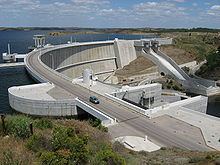Official name Barragem do Alqueva Location Alqueva/Moura Opening date 2002 Construction cost 1.7 billion USD | Country Portugal Status Operational Opened 2004 Construction began 1995 | |
 | ||
Purpose Water supply, irrigation, power, tourism Engineering firm COBA, Consultores para Obras, Baragens, e Planeamento Contractors Somague - Sociedade de Construções, Bento Pedroso Construções SA, Acciona Similar Castelo de Monsaraz, Pulo do Lobo, Parque Temático Natural A, Castle of Mourão, Our Lady of Help Bridge | ||
Europe s biggest dam and artificial lake alqueva dam
The Alqueva Dam is an arch dam and the center-piece of the Alqueva Mutlipurpose Project. It impounds the River Guadiana, on the border of Beja and Évora Districts in south of Portugal. The dam takes its name from the town of Alqueva to its right bank. It creates a large reservoir with an inter-annual regulation capacity from which water may be distributed throughout the region. The dam was completed in 2002 and its reservoir reached the full level, for the first time, in 2010. The 518.4-megawatt (695,200 hp) power station was commissioned in two stages, stage I in 2004 and stage II in 2013. The Alqueva Dam constitutes one of the largest dams and artificial lakes (250 square kilometres (97 sq mi)) in Western Europe.
Contents
- Europe s biggest dam and artificial lake alqueva dam
- Map of Alqueva Dam Moura Portugal
- Portugal the alqueva dam barragem de alqueva
- HistoryEdit
- Hydroelectric power stationEdit
- Supporting infrastructureEdit
- BenefitsEdit
- DestructionEdit
- References
Map of Alqueva Dam, Moura, Portugal
Portugal the alqueva dam barragem de alqueva
HistoryEdit
During the 1950s, the Portuguese Prime Minister, António de Oliveira Salazar, ordered a study of the feasibility of the dam project. The potential benefits of the Alqueva dam were discussed for decades. An initial effort was undertaken after the Carnation Revolution of 1974, but it was abandoned in 1978. The Portuguese government eventually made a firm decision to build the dam in the 1990s, during the Cavaco Silva and António Guterres governments.
Aldeia da Luz, a small village that lay in the projected flood zone of the dam, was completely rebuilt on a new site.
The construction of the new dam was carried out by a joint venture of Bento Pedroso Construções, Cubiertas y MZOV, Dragados and Somague - Sociedade de Construções.
On February 8, 2002, the 96-metre (315 ft) high floodgates of the Alqueva dam were closed. In January 2010 the lake was filled to the planned level, with a surface area of 250 km2.
Hydroelectric power stationEdit
In 2004, the first stage of the hydroelectric power station was commissioned, with a capacity of 259-megawatt (347,000 hp) megawatts. The second stage, with an additional 259 MW, was commissioned in 2013. The power station contains four 129.6-megawatt (173,800 hp) reversible Francis turbines. With these turbines, the power station is afforded a pumped-storage capability. Power is generated during high demand periods and at times of low demand, the turbines reverse and pump water from a much smaller reservoir below the dam back into the main reservoir. Pedrogao Dam forms the lower reservoir.
Supporting infrastructureEdit
Complementing the Alqueva dam, which is equipped with a pumped-storage hydroelectric plant, is the Pedrógão Dam, located 23 kilometres (14 mi) downstream from Alqueva beside the settlement of the same name and also equipped with a mini hydroelectric plant. The purpose of the Pedrógão dam is the creation of a lower reservoir for the Alqueva, for the recovery of flows, also serving as a source of water for the Ardila and Pedrógão water supply subsystems. The Álamos pumping station takes water from Alqueva and distributes it throughout the entire Alqueva water supply subsystem. Another two pumping stations, Pedrógão/Left Bank and Pedrógão/Right Bank, distribute water to the Ardila and Pedrógão subsystems respectively. The main infrastructure also includes the primary and secondary networks, pumping stations, intermediate dams, reservoirs and drainage and road networks.
BenefitsEdit
The goals of the Alqueva Multi-Purpose Project have been based on the principal shortfalls of the Alentejo region. The answers to these needs make up the project's main goals:
DestructionEdit
The dam caused the loss of Pre-historic engravings and habitat of rare and engendered species including eagles, kites, wild boars, and the Iberian lynx. A Roman fort was also submerged.
The Alqueva Multi Purpose Project has a strong financial investment in impact mitigation plans. The archaeological intervention of about 1,200 cultural heritage sites is one result.
An environmental leader, José Paulo Martins, says the dam is a waste of money, as "the government's own secret reports say only 48% of the irrigated land can be worked profitably".
